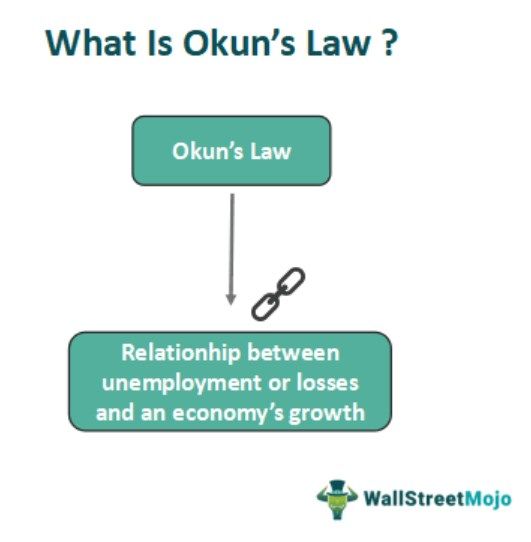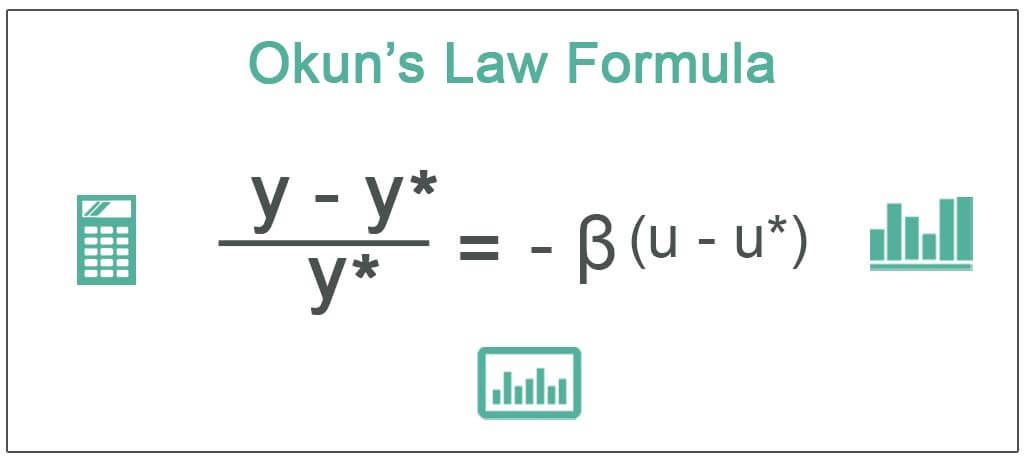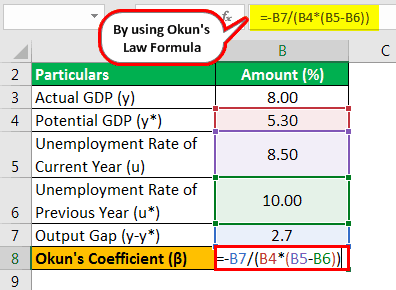Table Of Contents
Okun’s Law Meaning
Okun’s Law refers to the observation on how the unemployment rate and losses influence the economic growth of a nation. According to this law, for every 1% fall in unemployment in an economy, the Gross Domestic Product (GDP) will rise by 2% and Gross National Product (GNP) will rise by 3%.

Okun’s Law helps an economy to be aware of the pace of growth it should maintain to ensure it never lags behind its global counterparts in terms of economic growth. The nations try their best to keep the rate of unemployment and other losses under control so that no negative impact is seen on the GDP.
Okun’s Law Explained
Okun’s law is named after Arthur Okun, an economist who published his research on the relationship between two major macroeconomic variables, unemployment, and production. It means that unemployment is inversely proportional to the GDP and GNP.
This law is known for its simplicity and accuracy. However, many doubts have been raised on this law as it does not hold fit in every state for every economy. To make it clear, in an industrialized economy with strong labor markets, the percentage change in GDP will have less effect on the unemployment rate.
Formula
The following formula gives Okun's law:

Where:
- y = Actual GDP
- y* = Potential GDP
- β = Okun Coefficient
- u = Unemployment rate of the current year
- u* = Unemployment rate of the previous year
- y-y* = Output Gap
So, the output gap (the difference between Actual GDP and Potential GDP) divided by Potential GDP is equal to the negative Okun coefficient (negative represents the inverse relationship between unemployment and GDP) multiplied by the change in Unemployment.
If we go by the traditional Okun’s law, the Okun coefficient would be 2 in all cases. However, this coefficient will not always be two in today's scenario and may vary according to economic situations.

Examples
Let us consider the following examples to see how the calculation is done:
Example #1
Let us take a hypothetical example where we have the following components given below and we have to calculate Okun Coefficient using the same.
Solution
From the information below, we have to calculate the Okun Coefficient.
| Particulars | Amount (%) |
|---|---|
| Actual GDP (y) | 8.00 |
| Potential GDP (y*) | 5.30 |
| Unemployment Rate of Current Year (u) | 8.50 |
| Unemployment Rate of Previous Year (u*) | 10.00 |
To calculate Okun's coefficient, we need first calculate the output gap
The calculation of Output Gap is as follows,

- = 8.00-5.30
- Output Gap = 2.7
Calculation of Okun's Coefficient can be done as follows:

- β =-2.7/(5.30*(8.50-10.00))
Okun's Coefficient will be -

- β = 0.34
- Okun Coefficient (β) = 0.34
Example #2
Next, let us take a practical industry example of the US Economy, and we have been provided with the following data from the Research Team. From the data provided below, we have to calculate the Okun Coefficient.
Solution
From the information below, we have to calculate the Okun Coefficient.
| Particulars | Amount (%) |
|---|---|
| Actual GDP (y) | 2.1 |
| Potential GDP (y*) | 3.21 |
| Unemployment Rate of Current Year (u) | 3.8 |
| Unemployment Rate of Previous Year (u*) | 3.2 |
To calculate Okun’s coefficient, we need first to calculate the output gap
Calculation of Output Gap is as follows,

- =2.1-3.21
- Output Gap = -1.1
Calculation of Okun's Coefficient can be done as follows:

- β = -(-1.1)/(3.21*(3.8-3.2))
Okun's Coefficient will be -

- β = 0.58
Okun Coefficient is 0.58
Example #3
Let us take a practical industry example of the UK Economy, and we have been provided with the following data from the Research Team. From the data provided below, we have to calculate the Okun Coefficient.
Solution
From the below information, we have to calculate the Okun Coefficient
| Particulars | Amount (%) |
|---|---|
| Actual GDP (y) | 5 |
| Potential GDP (y*) | 2 |
| Unemployment Rate of Current Year (u) | 1 |
| Unemployment Rate of Previous Year (u*) | 2.2 |
To calculate Okun's coefficient, we need first to calculate the output gap
Calculation of Output Gap is as follows,

- =5-2
- Output Gap = 3
Calculation of Okun's Coefficient can be done as follows:

- β = -3/(2*(1-2.2))
Okun's Coefficient will be -

- β = 1.25
- Okun Coefficient = 1.25
Relevance and Use
The circle of the economy starts with investment. When people invest in any business, the relevant industry gets boosted. Investment results in an increase in production levels which requires the labor force, and again it results in growth in the employment rate. So, a decrease in the unemployment rate eventually enhances the country's GDP. Various industries and sectors (goods and service sector) contribute to the country's GDP.
Okun’s formula runs on this logic. Arthur Okun’s Law says that for every 1% decrease in unemployment, GDP will increase by 2%. However, this theory doesn’t hold good for every economy in today's scenario. Okun’s law acts in the same manner, i.e., when the rate of unemployment decreases, the GDP of the country increases and vice versa but the Okun Coefficient may vary from country to country depending on the varying economic situations.

